 |
 |
 |
| City &
Highlight Sightseeing ::
Shiraz ::
Persepolis |
 |
 |
|
PERSEPOLIS
ACCOMMODATIONS |
 |
|
|
 |
|
 |
|
 |
 |
|
PERSEPOLIS SPECIALS: |
 |
 |
|
ALL HOTELS &
GUESTHOUSES: |
|
   |
|
The
center of the great Persian Empire, ceremonial
capital of the Achaemenians and the showpiece of
Achaemenian art, Persepolis (Capital of Persia, in
Greek) is a historic site in Fars Province, 60 km to
the northeast of Shiraz by road, for which the
Iranians have got their own name: Takht-e Jamshid
(The Throne of Jamshid), Jamshid being the first,
probably mythical, ruler of Iran. It is 420 km south
of Esfahan and 835 km south of Tehran on a
first-class asphalt road. It can be reached by air
through Shiraz international airport.
The most important source of our knowledge on
ancient Iran, its various royal buildings, -
palaces, audience halls, treasury, store rooms,
stables, etc. were built, as indicated in an
inscription carved on stone, during the reign of
Darius the Great (521-486 BC) and by his command,
and further developments made under Xerxes I,
Artaxerxes, Xerxes II, Darius II, Cyrus II,
Artaxerxes II and III, and Darius III (336-331 BC),
the whole process taking about one hundred and fifty
years. This magnificent court was the summer
residence of Achaemenian emperors and their official
reception quarters.
More>>
 |
 |
 |
| |
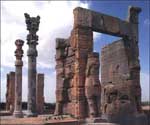
|
The Gate of All Nations
At the head of the staircase is the Gate
of All Nations, built during the reign
of Xerxes I. It impresses with its
massiveness. Its Four Corners is
oriented to the four cardinal
directions; the entrance is through the
western doorway. It is guarded at east
and west by vast bull-like colossi
closely akin to the bull figures of
Assyria.
More>>
|
|
|
|
 |
 |
 |
 |
 |
 |
| |
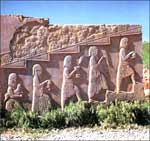
|
Peoples under the Persian dynasty .
Kushyia (Ethiopians), with closely
curled hair and Negroid features,
carrying a vase and an elephant tusk and
leading an okapi.
Putaya (Libyans), escorting a kudu with
long curved horns, and horse-drawn
chariot.
Zranka (Dranjianians), including a
lancer with a shield and a long-horned
bull (some believe these are Arachosians,
mountain folk from Kerman region, and
cattle breeders).
Arabaya (Arabians), with textiles and a
dromedary.
Skudra (Skudrians), lancers carrying
shields, and a horse led by soldiers who
wear classical type Thracian helmets.
The Asagarta (Sagartians), wearing
tasseled caps (like those of the
Capadoicians and Armenians), two of
which are fastened under the chin like
Balaclava helmets.
Sogda (Sogdians), or as some believe
Chorasmians, holding a short sword,
bracelets and axes and leading a horse.
More>> |
|
|
|
 |
 |
 |
 |
 |
 |
| |

|
Hadish
An unfinished palace of Artaxerxes III
lies across the courtyard to the south,
and to the east of the Tachara, on the
highest part of the platform and, like
all the palaces, standing on its own
terrace, is the main hall of the Hadish
(literally, a Dwelling Palace), Xerxes
private palace which can be reached by a
staircase from the courtyard.
The central hall of the Hadish with its
36 columns, approached by the northern
porch with 12 columns, is surrounded by
small chambers on the east and west, and
has five doorways whose portals depict
Xerxes entering or leaving the palace,
accompanied by attendants.
More>> |
|
|
|
 |
 |
 |
 |
 |
 |
| |
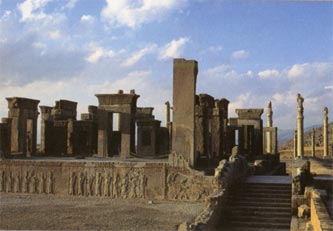
|
Hall of 100 Columns
To the east of Tripylon and the Apadana
and immediately to the north of the
Treasury, is the largest edifice on the
platform the Hall of One Hundred
Columns, measuring 70 x 70 meters in
area, covered with some three meters of
soil and cedar ash when it was first
partly excavated by Motamed od-Dowleh
Farhad Mirza, governor-general of Fars,
in 1878. It was used for the reception
of the delegations of the subject
peoples and collection of their tribute.
It is the most functional building in
the complex; it shows the psychology of
Persian statecraft at its highest. The
king entered the palace through the side
door, positioned himself on the throne
in the center of the hall, and
surrounded by the nobles and the staff
of the treasury.
More>> |
|
|
|
 |
 |
 |
 |
 |
 |
| |
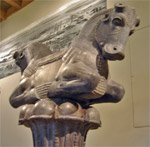
|
Museum
Museum is reached through the southern
gate of the 100 Column Palace. It
contains not only objects found in
Persepolis but, in the right-hand
galleries, prehistoric pottery and
artifacts from nearby mounds including
Tall-e Bakun, and on the left early
Islamic exhibits from Istakhr. On
leaving the Museum turn sharp right and
follow the outer wall of the Museum
until you come to a small covered recess
with several office doors. In the wall
of this recess are two panels of
Achaemenian tile, which, though faded,
show the vivid colors used. The entire
palace was similarly covered in colored
tiles or painted.
|
|
|
|
 |
 |
 |
 |
 |
 |
| |
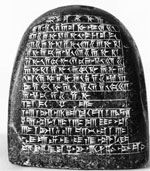
|
Treasury
East of the Museum, at the foot of the
mountain face, is a self-contained
complex of halls covering over 10,000
Square meters, including two large halls
whose roofs were supported respectively
by 100 and 99 wooden columns, and which
is believed to have been the Treasury
begun by Darius. Stone and clay tablets
in Akkadian and Elamite found here gave
details of exact wages in cash and in
kind, paid to the men who built
Persepolis, proving that this gigantic
undertaking was constructed by free,
paid labor, in contrast to contemporary
monumental buildings in other countries
where slave labor was the rule. |
|
|
|
 |
 |
 |
|
 |
|
 |
|
|
|
| Suggest your comments about nearby Sightseeing |
Private and group tours Tours , also Accommodation reservation services are available at
www.PersiaTours.com for further information , please contact us.
Use the following keywords to find this page online:
Persepolis, Travel Iran Persepolis , Iran
Persepolis vacations, Iran Persepolis tourism, Iran
Persepolis hotels, deals, Iran Persepolis historical travel tour, Iran
Persepolis visitors
guide, Iran Persepolis advice, Iran Persepolis map, Iran Persepolis pictures, Iran
Persepolis
information, Iran Persepolis ratings, Iran Persepolis reviews, Iran
Persepolis airport, Iran
Persepolis weather, Iran Persepolis things to do, Iran
Persepolis attractions, Iran
Persepolis cultural tours iran
, Iran Persepolis travel to Iran, Iran Persepolis Iran tours, Iran
Persepolis Iran touring,
Iran Persepolis Iran tourism, Tour to Iran Persepolis , Tours in Iran
Persepolis , Iran
Persepolis
tour operator, Adventure tours in Iran Persepolis , Business Travel to Iran
Persepolis ,
Business Trip to Iran, Archaeology tour in Iran Persepolis , Pilgrim tours in Iran
Persepolis , Persian tours Iran Persepolis , cultural tours in Iran
Persepolis , geographical
tours in Iran Persepolis , Persia, tour to Persia, Trekking tours in Iran
Persepolis , hunting tours in Iran , historical
tours in Iran , climbing tours in Iran Iran
Persepolis |
|
|
|
|
 |
 |
 |




